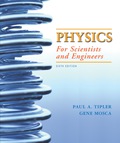
Concept explainers
(a)
The focal length of eyepiece.
(a)
Explanation of Solution
Given:
Magnifying power of microscope is
The angular magnification of eyepiece is
The distance of objective lens from eyepiece is
Formula used:
Write expression for angular magnification of eyepiece.
Here,
Calculation:
Substitute
Conclusion:
Thus, the focal length of eyepiece is
(b)
The location object so that it is in focus for normal eye.
(b)
Explanation of Solution
Given:
Magnifying power of microscope is
The angular magnification of eyepiece is
The distance of objective lens from eyepiece is
Formula used:
Write expression for angular magnification of eyepiece.
Here,
Write expression for image distance.
Write expression for magnifying power of microscope.
Rearrange above expression for
Substitute
Substitute
Rearrange above expression for
Calculation:
Substitute
Substitute
Conclusion:
Thus, the object is
(c)
The focal length of objective lens.
(c)
Explanation of Solution
Given:
Magnifying power of microscope is
The angular magnification of eyepiece is
The distance of objective lens from eyepiece is
Formula used:
Write expression for angular magnification of eyepiece.
Here,
Write expression for image distance.
Write expression for magnifying power of microscope.
Rearrange above expression for
Substitute
Substitute
Rearrange above expression for
Write expression for lens equation for objective lens.
Calculation:
Substitute
Substitute
Substitute
Conclusion:
Thus, the focal length of objective lens is
Want to see more full solutions like this?
Chapter 32 Solutions
Physics for Scientists and Engineers
- A capacitor with a capacitance of C = 5.95×10−5 F is charged by connecting it to a 12.5 −V battery. The capacitor is then disconnected from the battery and connected across an inductor with an inductance of L = 1.55 H . At the time 2.35×10−2 s after the connection to the inductor is made, what is the current in the inductor? At that time, how much electrical energy is stored in the inductor?arrow_forwardCan someone help me with this question. Thanks.arrow_forwardCan someone help me with this question. Thanks.arrow_forward
 Principles of Physics: A Calculus-Based TextPhysicsISBN:9781133104261Author:Raymond A. Serway, John W. JewettPublisher:Cengage Learning
Principles of Physics: A Calculus-Based TextPhysicsISBN:9781133104261Author:Raymond A. Serway, John W. JewettPublisher:Cengage Learning Physics for Scientists and Engineers, Technology ...PhysicsISBN:9781305116399Author:Raymond A. Serway, John W. JewettPublisher:Cengage Learning
Physics for Scientists and Engineers, Technology ...PhysicsISBN:9781305116399Author:Raymond A. Serway, John W. JewettPublisher:Cengage Learning Physics for Scientists and Engineers: Foundations...PhysicsISBN:9781133939146Author:Katz, Debora M.Publisher:Cengage Learning
Physics for Scientists and Engineers: Foundations...PhysicsISBN:9781133939146Author:Katz, Debora M.Publisher:Cengage Learning University Physics Volume 3PhysicsISBN:9781938168185Author:William Moebs, Jeff SannyPublisher:OpenStax
University Physics Volume 3PhysicsISBN:9781938168185Author:William Moebs, Jeff SannyPublisher:OpenStax College PhysicsPhysicsISBN:9781285737027Author:Raymond A. Serway, Chris VuillePublisher:Cengage Learning
College PhysicsPhysicsISBN:9781285737027Author:Raymond A. Serway, Chris VuillePublisher:Cengage Learning College PhysicsPhysicsISBN:9781305952300Author:Raymond A. Serway, Chris VuillePublisher:Cengage Learning
College PhysicsPhysicsISBN:9781305952300Author:Raymond A. Serway, Chris VuillePublisher:Cengage Learning





